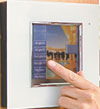

Energy conservation made simple with Schneider.
Lighting is estimated to consume over 20% of electricity produced and is responsible for about 35% of a typical building’s electricity use. Much of it is wasted due to poor lighting design, inefficient lighting equipment and inadequate control. Now with pending mandatory energy codes requiring lighting control in new buildings, lighting design and engineering professionals are facing greater demands for energy conservation than ever before.
Schneider Electric recommends lighting control systems such as C-Bus Lighting Control, which can be integrated with a building’s management system. “The combination of lighting control with HVAC systems and other building services enables a huge energy saving potential,” says Schneider Electric South Africa product manager, Nico van der Merwe.
“It is important to bear in mind that reducing the connected load on the lighting system only represents half the potential energy saving. The other 50% entails minimising the use of that load through automatic controls, which switch or dim lighting based on time, occupancy, lighting level strategies, or a combination of all three,” he explains. “In situations where lights are often left on longer than needed, in unoccupied areas, or when sufficient daylight exists, companies should consider installing automatic controls as a supplement to manual ones.”
Automatic controls that can switch lights on and off or dim them based on input from timers, occupancy sensors that detect motion or infrared radiation from a person, photo sensors that adjust light levels based on the available daylight, or sensors that operate lighting by voice or sound can be zoned to provide pre-programmed lighting levels (scenes) for different situations.
Many systems also include the option of remote control via phone, computer or a standard remote control. Hard-wired controls usually rely on low-voltage bus wiring for signal transmission, however, some products transmit signals over standard wiring and therefore require nothing additional.
According to Van der Merwe, dimming is an effective tool in lighting-system designs to reduce energy consumption and increase aesthetic appeal while still providing appropriate light levels. Dimmer switches can allow one fixture to serve several lighting functions, such as task lighting at full ballast and decorative or safety lighting on a lower setting. A light that is dimmed by 25% uses about 20% less energy, while the lamp life is increased fourfold.
Today it is possible to dim most popular fluorescent lamp types and Schneider Electric controls are compatible with virtually all available solid-state dimming ballast choices. The C-Bus lighting control system provides dimming functions through a variety of user interfaces and programmes such as simple manual control, preset lighting scenes, automatic daylight harvesting and load shedding.
“All things considered, simply switching off lighting when it is not required still results in substantial energy savings,” Van der Merwe states. “Therefore, regardless of the amount of automation used for lighting control, the ability to manually override lighting is an important element in the overall design of a new building. Schneider Electric controls offer a variety of choices for manual override of lighting in systems including simple low-voltage wall switches and networked button stations.
“Designing an optimal lighting control system may incorporate several types of controls and strategies to achieve an integrated, total-facility approach, but ultimately the goals remain the same: a well-designed and effective lighting control must save energy, reduce operating costs and help maintain a safe and productive environment for occupants.”
For more information contact Nico van der Merwe, Schneider Electric South Africa, +27 (0)11 254 6400, [email protected], www.schneider-electric.co.za
| Tel: | +27 11 254 6400 |
| Email: | [email protected] |
| www: | www.se.com/za/en/ |
| Articles: | More information and articles about Schneider Electric South Africa |

© Technews Publishing (Pty) Ltd | All Rights Reserved